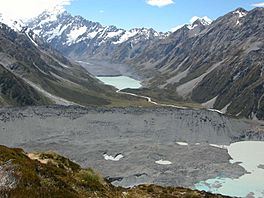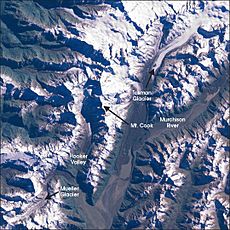Mueller Glacier facts for kids
Quick facts for kids Mueller Glacier |
|
|---|---|

Mueller glacier (under rubble) and its moraine (foreground). Aoraki / Mount Cook washed out in the background. The Hooker Glacier and its terminal lake are up the valley in the distance.
|
|
| Type | Mountain glacier |
| Location | New Zealand |
| Coordinates | 43°44′S 170°03′E / 43.733°S 170.050°E |
| Length | 13 km (8.1 mi) |
| Terminus | Mueller Glacier lake (unnamed) |
| Status | Retreating |
The Mueller Glacier is a long river of ice found in Aoraki / Mount Cook National Park in the South Island of New Zealand. It stretches for about 13-kilometre (8.1 mi), which is like traveling the length of 130 football fields! This amazing glacier is located near Mount Cook Village within the Southern Alps, a huge mountain range.
Contents
Where is the Mueller Glacier?
The Mueller Glacier starts high up in the mountains near Mount Montgomerie. It flows generally towards the north-west. As it moves, it curves around a mountain range called Sealy Range. Many other smaller glaciers join the Mueller Glacier along its path. These include the Frind and Huddleston Glaciers, which add more ice to it.
The Glacier's End Point
The Mueller Glacier doesn't flow into the ocean. Instead, it ends at a small lake that doesn't have a special name. This lake is called a terminal lake because it's at the end of the glacier. The lake is also fed by melting ice from the nearby Hooker Glacier. Water from this lake then flows into the Hooker River. The Hooker River is a small stream that eventually joins the Tasman River, which flows into Lake Pukaki.
Who Was Mueller?
The Mueller Glacier was named after a famous person named Ferdinand von Mueller. He was a botanist and explorer from Germany who lived in Australia. A botanist is a scientist who studies plants. Baron von Mueller explored many places and discovered new plants. Naming the glacier after him was a way to honor his important work.
A Look into the Past
Scientists have studied the Mueller Glacier to learn about its history. They looked at a special yellow-green plant called a lichen. By studying how big these lichens were, they could figure out when the glacier was at its biggest. They believe the Mueller Glacier was much larger between the years 1725 and 1730. This time is known as the Little Ice Age. During the Little Ice Age, many parts of the world experienced cooler temperatures.
What is a Moraine?
When glaciers move, they act like giant bulldozers. They push and carry rocks, dirt, and other debris along with them. When the glacier melts and retreats, it leaves behind piles of these materials. These piles are called moraines. A small hill called White Horse Hill, located north of Mount Cook Village, is actually a moraine. It shows us where the Mueller Glacier used to be during the Little Ice Age. It's like a natural monument to the glacier's past size!


